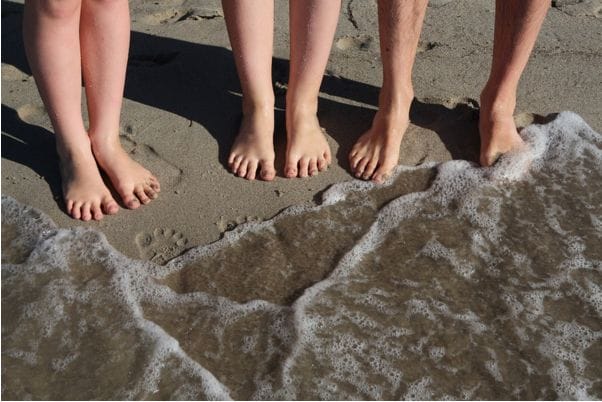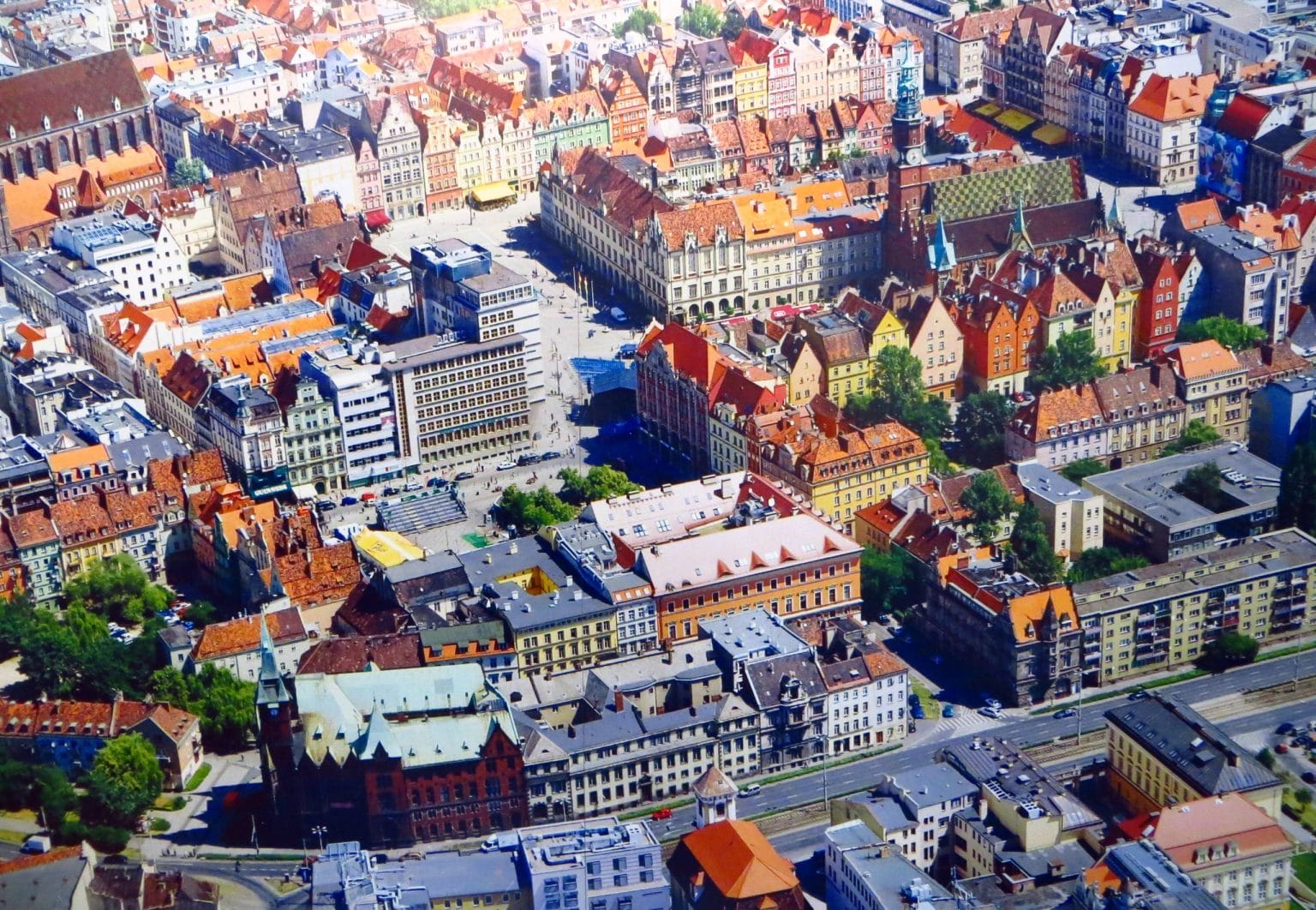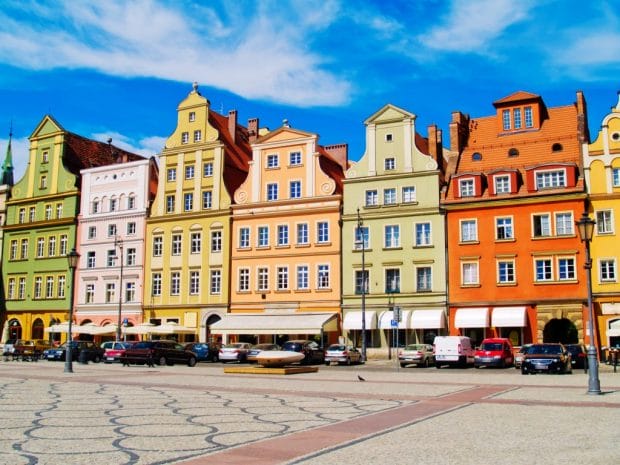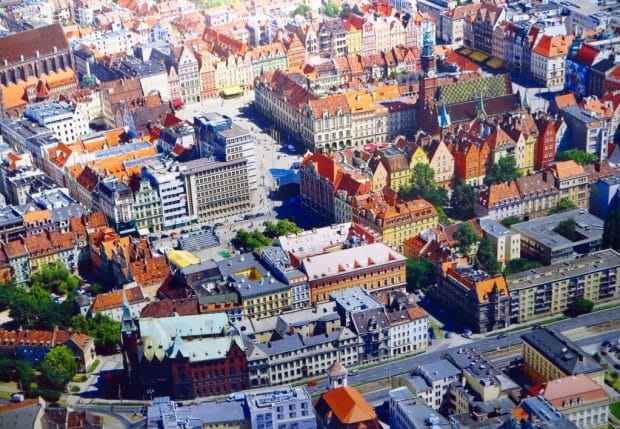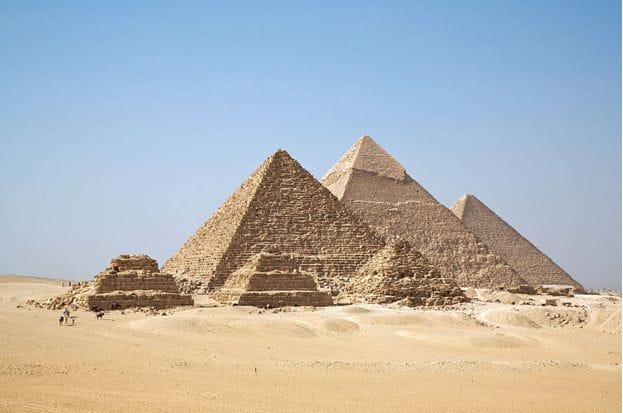Krakow and Warsaw are well-known destinations but Wroclaw, the “Venice of Poland” is rapidly establishing itself in the international travel spotlight as one of the most exciting Polish short break destinations.
Poland’s fourth City and the historic capital of Silesia, Wroclaw, pronounced “Vrahts-waf”, is a newly discovered European gem. A meeting point between east and west Europe this developing modern commercial, cultural and activity centre has gained confidence from being a host City to the UEFA Euro 2012, World Weightlifting Championship 2013 , the chosen site for the World Book Capital 2016 and World Games 2017 as well as being named European Capital of Culture 2016, and venue for the European Film Awards 2016 .
The City previously known as Breslau, has been at the heart of European history having at various times been part of Bohemia, the Austrian Empire, Prussia, and latterly Germany before being incorporated within Polish territory in 1945. A fortress City on the River Oder since the 10th Century, it was partially destroyed during the Russian advance in latter stages of World War 2. However the old City of “twelve islands” and over 100 bridges has since been painstakingly restored and is now counted amongst the best architectural highlights of Central Europe.
The colourful and interesting past is reflected in the City’s fascinating architectural and cultural heritage, but what differentiates this University City which has spawned 10 Nobel Prize winners, is its well developed lively cultural scene and its value for money reputation.
Cultures old and new
On the journey into the City centre you may notice the 3 faces of modern Wroclaw. The brash new commercial buildings like the Sky Tower (until recently the country’s tallest) that represent the modern confident Poland, the soulless concrete accommodation blocks of the “Soviet” era, and the picturesque historic old City and Cathedral Islands with their Bohemian, Austrian and Prussian influences. Together they create an eclectic mix of old and new cultures.
What to see
Whatever your schedule find time to stroll around the Old Town where you will discover splendid and colourful historic buildings as well as the best shops, bars, galleries and museums. At its heart is the Rynek, the splendid medieval Square and meeting place – one of the largest in Europe. In the centre is the massive 14th-century Ratusz (City Hall) with its 66 metre tower now houses the Museum of Bourgeois Art and The Municipal Museum as well as the Spix Brewery and the cellar Restaurant “Piwnica Swidnicka” often advertised as the oldest restaurant in Europe. Also look out for the astrological clock on the eastern facade dating from 1580. Overlooking the square is the grand and imposing St Elisabeth’s Church, which also dates back to the 14th century. Climb the 300 steep steps to reach the observation deck at the top of the church’s 91m spire, and gaze out over the city. 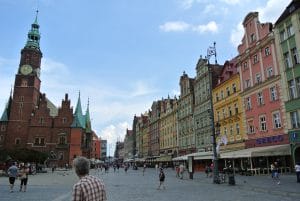 South of the Rynek is another church tower to ascend, St. Maria Magdalen where unusually you can walk the bridge between the twin spires. North of the Market Square is the historic University Quarter, dominated by the Wroclaw University building with its baroque masterpieces (you must see the opulence of the Aula Leopoldia) and also where you will discover bargain eateries and interesting bookshops.
South of the Rynek is another church tower to ascend, St. Maria Magdalen where unusually you can walk the bridge between the twin spires. North of the Market Square is the historic University Quarter, dominated by the Wroclaw University building with its baroque masterpieces (you must see the opulence of the Aula Leopoldia) and also where you will discover bargain eateries and interesting bookshops.
To the east of the old Town is Slowackiego Park where two of Wroclaw’s most popular attractions are located. The National Museum, home to one of the largest Polish art collections, and nearby the purpose-built Rotunda that houses the magnificent Raclawice Panorama – a 114 by 15 metre cylindrical painting designed to commemorate the 1794 Kosciuszko Insurrection, when a Polish rebellion defeated the Russian army.
You will certainly notice the many Dwarfs of Wroclaw. These small statuettes set into pavements can be found all over the city. Another interesting spectacle on the corner of Pilsudskiego and Swidnicka is the collection of huddled bronze figures breaking out of the pavement (The Anonymous Pedestrians). These have been created not merely as fascinating street art but to commemorate the activity of the 1980s Orange Alternative democracy protest movement (part of Solidarity).
Although the Old Town is the heart of Wroclaw, its soul and origin is Ostrów Tumski, a group of picturesque islands a short walk across the Tumski Bridge north east of the Rynek. This tranquil area, its cobblestone alleys still lit by original gas lamps, is the religious centre of the City with its stunning 13th Century Gothic landmark Cathedral of St. John the Baptist. There are many interesting religious buildings as well as the Botanical Gardens in the vicinity but the Cathedral itself features stunning stained glass windows, a 16th century altarpiece and a pipe organ built for the Centennial Hall which was once the largest in the world. Take the lift up the 98m Spire for great views of the Islands, and at dusk see the lamplighter creating the romantic evening setting in Ostrów Tumski.
Across the River Oder you will find evidence of a more prosperous age – grand boulevards, stately mansions and apartments. Venture further east and you will discover the modernist UNESCO listed 1913 Max Berg Centennial Hall (the Hala Ludowa or Peoples Hall) and the fantastic 40 metre high Pergola Multimedia Fountain (an ice rink in Winter), the Wroclaw Zoo – with over 7,000 animals, the Japanese Garden and the Olympic Stadium built by Hitler and named after Herman Goering to support the 1936 Berlin Olympics – now a speedway track.
South of the Old Town, the Royal Palace is worth a view. Beautifully restored from wartime damage and now housing the City Museum this was the residence of the Prussian Hohenzolern Emperors from the 17th to 20th Century. Further South, to get the best aerial panoramic view of Wroclaw and its surroundings take the lift to the 49th floor Observation Deck of the Sky Tower. Completed in 2012, this 212 metre-high building housing office, apartment, shopping and leisure facilities is one of the tallest in Poland.
What To Do
There are plenty of tours (self guided and organised) to view the historic and cultural sights in Wroclaw and its surrounds, but like most places in central Europe the season will determine some of the outdoor opportunities. During April to October the best way to take in the charm and beauty of the City is to explore its many canals. Boat trips and short cruises on the Oder are plentiful during day and night; in December, January and February the temperature averages around zero so indoor or more adventurous activities may be appropriate! The Aquapark like shopping is something that can be enjoyed year round !
Wroclaw is the shopping mecca for the region. The Renoma included on the Register of Historical Monuments was the premier shopping venue in the 1930s. It has recently been modernised and restored, now houses over 120 shops, cafes and restaurants with the roof terrace offering a panoramic experience. Wroclaw’s other City Centre shopping malls are Arkady, Galeria Dominikanska and Likus ; while on the edge of the City are the City Sky Tower, Pasaz Grunwaldzki and Magnolia Park – the largest shopping venue covering over 240,000 square metres. If you are looking for something local to take home – Vodka and Amber are the items to buy.
Wroclaw’s nightlife is wide-ranging, from theatre, opera and philharmonic venues to nightclubs and “stag activities” – there over 100 bars and clubs catering for all tastes. Kuznicza street is the location for cheap eateries and “student” bars, while most of the islands have restaurants with lovely riverside views, but the Old Town and particularly Market Square is the place for meeting and the focus for restaurants, cafés, pubs and clubs. The Spiý micro brewery, located in the basement of the new Town Hall offers homemade wheat beer which is excellent consumed with wholemeal bread and smalec – a traditional Polish “dripping” made from lard and spices. In fact Wroclaw cuisine as its history suggests has a multi-cultural base following German, Austrian, Italian and Slavic traditions using staple meats and winter vegetables – featuring soups, sausages and dumplings.
There are many regular festivals and events in Wroclaw covering food and drink including the Good Beer Festival in May, music and opera, cinema and films, books and literature, sport and of course the festive Xmas Market through December.
For the young and adventurous Wroclaw is now becoming a popular activity destination with opportunities for parachute jumping, zorbing, off-road 4×4, white water rafting, ballooning and live ammo range shooting with AK47, glock and pump action shotguns. Just the basis for a “lads weekend”. For the really adventurous there are number of operators catering for the “Stag” market – providing packages that include any of the above activities plus pubs, clubs and more!
Wroclaw Travel & Accommodation
Located in south west Poland, new motorways connect Wroclaw with Berlin in the west, to Krakow in the East, while the newly refurbished 19th Century neo gothic Rail Station provides a leisurely but grand entrance into the heart of the City with trains from Warsaw, Krakow, Germany and Czech Republic. However, for many visitors the gateway to Wroclaw is the new Copernicus Airport. Situated 13 kilometres from the City Centre it is served by several airlines including low cost carriers to destinations across Europe.
The City Centre itself is flat and easily tackled on foot or taxi, but there is also an excellent inexpensive public transport network with extensive bus and tram routes for getting around the City and venturing into the suburbs. The City has also developed a network of bike paths and a bike rental system, Wroclaw City Bike, for the more eco-minded.
In recent years the City has developed a range of hotel and hostel rooms to suit visitors of all budgets, including the beautifully renovated 19th Century 5 star Monopol Hotel which has hosted guests as diverse as Greta Garbo, Adolf Hitler and Prince Andrew.
Whatever your taste and size of pocket there is good value to be had in Wroclaw. So what are you waiting for?

